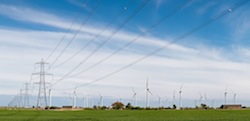One of the hurdles for wind and solar energy is getting hooked up with the electrical grid. It is estimated that states like North Dakota could provide massive amounts of wind energy to the country, but today, the energy is produced too far where it is needed without having an updated energy grid. Fortunately, a new report released by Edison Electric Institute (EEI) has found there are more than 100 electric transmission projects either planned or underway in the U.S.
 EEI’s member electric utility companies have reported they plan to spend $64 billion on transmission system improvements from now through 2022. This is on top of the already $77 billion spent between 2001-2010. The report includes a brief overview of each member company including detailed information about their projects.
EEI’s member electric utility companies have reported they plan to spend $64 billion on transmission system improvements from now through 2022. This is on top of the already $77 billion spent between 2001-2010. The report includes a brief overview of each member company including detailed information about their projects.
“Although not a comprehensive compilation of all projects that are being undertaken by our member companies,” said EEI’s Vice President of Energy Delivery, James P. Fama, “the sampling of projects highlighted in the EEI report, Transmission Projects: At A Glance, March 2012, highlights the electric power industry’s commitment to investing in needed and beneficial transmission infrastructure over the next 10 years.”
In addition to specific project information, the report also categorized each project into four areas:
- Interstate Transmission Projects—transmission line improvements that physically span two or more states.
- Transmission Supporting the Integration of Renewable Resources—transmission projects, whether transmission line or non-transmission line, that support the integration of a renewable resource.
- Transmission Projects Required for System Reliability Needs—projects where the predominant driver has been identified as the need to meet either NERC reliability standards (e.g., NERC Transmission Planning TPL standards) and/or local Transmission Owner reliability criteria.
- Transmission Projects Developed by Multiple Project Partners—transmission projects where EEI member companies are partnered with other utilities, including non-EEI members, to leverage their expertise to develop the project.
You can download the full report here.

